 Iceland
Iceland
Energize your spirit with the magical Northern Lights and soothe your body with geothermal hot springs in the Land of the Midnight Sun. Let your mind be inspired by the culture, from ancient to modern, in the world’s most northerly capital of Reykjavik, a UNESCO City of Literature, and home of one of the world’s oldest Parliaments. All the while, a backdrop of rugged mountains serves as a constant reminder of Iceland’s tumultuous, volcanic past.
Tours & Packages
- Destinations: Iceland
- including closed packages
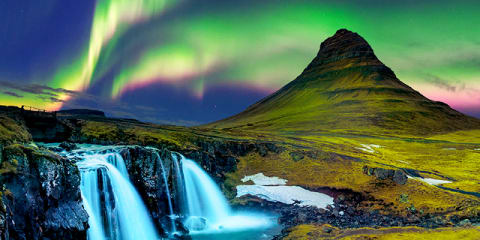
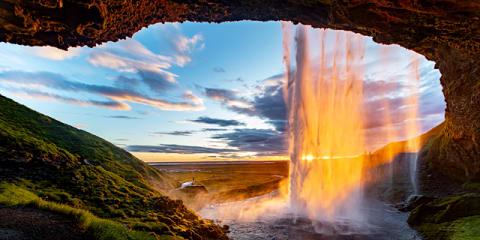

Trip Reviews & Photos
We love hearing your stories and seeing your photos! Check out our entire fan photo gallery and upload your photos.
Highlights
- Northern lights
The phenomenon of aurora borealis, more commonly known as the Northern Lights, lights up in streaks of blue and green and dances across Iceland's dark winter skies. The fascinating event results from solar particles entering the Earth's magnetic field and ionizing high in the atmosphere. The Aurora Borealis gets its name from the Roman goddess of dawn, Aurora, and the Greek word for the north wind, Boreas. The best time to see the Northern Lights is during the winter, between September and April when long, dark nights have taken over from Iceland's midnight sun. The Northern lights are at the top of many peoples' bucket lists, and it's no surprise why!
- Reykjavik
Iceland's exciting capital may be the smallest big city in the world, with so many things to see and do! Reykjavík is the natural starting point for any visit to Iceland and is world-renowned for its culture, history, and natural beauty. Admire the unique street art found around every corner; Hallgrímskirkja, the largest and tallest church in the country; Sólfarið, The Sun Voyager, the waterfront sculpture and one of the city's most iconic landmarks; and Harpa, the concert hall that hosts the Iceland Symphony Orchestra, The Icelandic Opera, and countless music festivals. Fun Fact: Besides being the world's northernmost capital, Reykjavik is the world's only capital city with a significant puffin breeding colony!
- Golden Circle route
The Golden Circle route is Iceland's most popular sightseeing trail, providing an easy and efficient way to see three of the country's top attractions in a day. Each stop offers insight into Iceland's geologic history and excellent photo opportunities with bursting geysers, roaring waterfalls, and a fissure between two tectonic plates. The iconic route includes Þingvellir National Park, a UNESCO World Heritage Site; Geysir Geothermal Area, home to two famous geysers; and Gullfoss waterfall, Iceland's most spectacular waterfall.
- Gullfoss
Located in the canyon along the Hvítá River, the mighty Gullfoss Waterfall attracts spectators year-round. "Gullfoss" translates to "Golden Falls," from the spectacular golden hue often shining in its glacial waters. Rushing waters plunge from 105 feet, and during its heaviest flow in the summer, it pours nearly 34,000 gallons of water every second! The great falls are known not only for their breathtaking power but also for the rainbows that appear above the falls on sunny days. Make sure your cameras are charged and ready to capture the stunning surrounding scenery, including the dramatic valley, rolling fields, and the magnificent ice sheet of Langjokull Glacier.
- National Parks
Iceland has established three national parks with unique nature and history. Explore Þingvellir National Park, a UNESCO World Heritage Site where the ancient Vikings had a parliament, making it one of the oldest parliaments in the world. The Þingvellir plain sits on a tectonic plate boundary where North America and Europe are slowly separating, resulting in the plain being scarred by dramatic fissures, ponds, and rivers, including the great rift Almannagjá. Journey to Europe's 2nd largest national park, Vatnajökull National Park, which covers about 14% of Iceland, and admire Jökulsárlón, a glacial lagoon filled with floating icebergs, Iceland's highest mountains, and Europe's largest glacier and the most powerful waterfall, Dettifoss. Finally, wander Snæfellsnes National Park and witness its mysterious Snæfellsjökull glacier, and then follow the adventure of Jules Verne's classic science-fiction novel, "The Journey to the Center of the Earth." This once-in-a-lifetime lava cave tour takes you over 114 ft underground and about 656 ft into the lava tube called Vatnshellir.
- Snæfellsnes Peninsula
The Snæfellsnes Peninsula is a region in western Iceland known for its beautiful and dramatic landscapes with lava fields, volcanoes, glaciers, black and white beaches, and soaring coastal cliffs. The scenic peninsula is often nicknamed "Miniature Iceland" due to the wealth and diversity of natural features found there. At its western tip, a rugged mountain chain runs its length, capped by the 4700 ft Snæfellsjökull glacier, a mystical cone-shaped stratovolcano rising from the sea at the peninsula's tip, wrapped in mythical stories from the past and present.
- The Blue Lagoon
Located on the Reykjanes Peninsula in southwest Iceland, the famous Blue Lagoon is one of Iceland's most popular attractions, and it's little wonder why! The lagoon's blue, soothing waters full of rich skin nourishment benefits are unlike anything else on Earth. Contrary to belief, the lagoon is not a natural hot spring but a pool created by a human-made structure. The history dates back to 1976, when it was formed next to a geothermal power plant, Svartsengi. In the early 1980s, people began bathing in the calming water to alleviate skin conditions. Today, with 102ºF waters year-round, the Blue Lagoon is a world-class spa catering to hundreds of thousands of visitors annually.
Fast Facts
Already booked on one of our packages to Iceland? See everything you need to know before you go.
| Overview | Capital: Reykjavik |
| Entry requirements | Please see our Entry Requirements page. |
| Weather | Iceland has mild winters due to the warming effect of the Atlantic Gulf Stream. Iceland enjoys a maritime temperate climate and the winters are often compared with those of New England. Iceland is the type of place where it's not unusual to get rained on and sunburned at the same time. The summers are usually cooler and more temperate than elsewhere at the same latitude. |
| What to wear | Icelandic winters are characteristic of very unpredictable and changeable weather, with daytime temperatures ranging from 20-40F. We strongly suggest using the three-layer method and bringing layers, such as t-shirts, long-sleeved shirts, and a jacket that protects against wind and rain. Dressing in layers is best as you can easily remove or add some clothes throughout the day. Evenings and mornings can be chilly, so pack warmer layers such as a light fleece or a wool sweater. If you have two pairs of comfortable (broken in, not brand new) walking shoes, bring both pairs. Since weather can be unpredictable anywhere in the world and to be sure you are comfortable during your trip and prepared for all types of weather possibilities, we recommend that you carry a small folding umbrella (or poncho) and take with you a jacket or sweater. Finally, remember that Iceland is casual, and comfort should dictate your wardrobe for the tour. |
| Money & Credit Cards | The local currency in Iceland is the Icelandic krona. Hotels and many stores throughout Iceland accept major credit cards. However, for "street shopping" or shopping in the countryside, you will need local currency. You can exchange your cash at the airport and local banks. You may also use the ATM machines to get cash in local currency. Credit cards are the most convenient way to pay for items you purchase as you travel. Be sure to call your credit card providers to let them know you will be traveling abroad, the places you’ll be visiting and the dates of your trip. This is important for your own protection. We suggest that you bring along cash in small denominations and we highly recommended that you bring crisp, new bills. Travelers’ checks are not accepted in Iceland. Always notify your bank prior to departure to avoid any problems using your credit or debit card while traveling. |
| Shopping | Typical Icelandic souvenirs are handmade hats and gloves. Icelandic sheep are a unique breed that produce a soft and durable wool that is soft and warm. Iceland has a huge number of excellent little craft shops that sell products from musical baskets and wonderful porcelain sculptures to paintings, glasswork and jewelery. |
| Electricity & Power Adapters | 220 volt. Plugs C & F. We recommend that you bring an adapter/converter along with you as not all hotels will have 110V (A&B plugs) outlets. Learn more about electrical standards around the world. |
| Cell Phones & Internet | Want to take your cell phone, tablet or laptop, but not sure how to get cell service or wifi? Read up on using your cell phone abroad and the top 5 ways to get Internet abroad. |


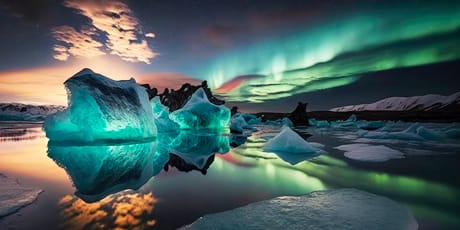 The phenomenon of aurora borealis, more commonly known as the Northern Lights, lights up in streaks of blue and green and dances across Iceland's dark winter skies. The fascinating event results from solar particles entering the Earth's magnetic field and ionizing high in the atmosphere. The Aurora Borealis gets its name from the Roman goddess of dawn, Aurora, and the Greek word for the north wind, Boreas. The best time to see the Northern Lights is during the winter, between September and April when long, dark nights have taken over from Iceland's midnight sun. The Northern lights are at the top of many peoples' bucket lists, and it's no surprise why!
The phenomenon of aurora borealis, more commonly known as the Northern Lights, lights up in streaks of blue and green and dances across Iceland's dark winter skies. The fascinating event results from solar particles entering the Earth's magnetic field and ionizing high in the atmosphere. The Aurora Borealis gets its name from the Roman goddess of dawn, Aurora, and the Greek word for the north wind, Boreas. The best time to see the Northern Lights is during the winter, between September and April when long, dark nights have taken over from Iceland's midnight sun. The Northern lights are at the top of many peoples' bucket lists, and it's no surprise why! 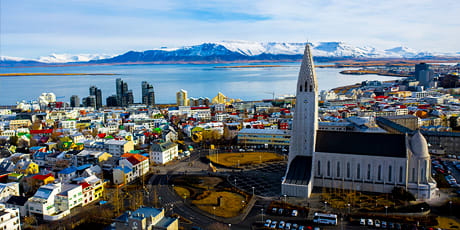 Iceland's exciting capital may be the smallest big city in the world, with so many things to see and do! Reykjavík is the natural starting point for any visit to Iceland and is world-renowned for its culture, history, and natural beauty. Admire the unique street art found around every corner; Hallgrímskirkja, the largest and tallest church in the country; Sólfarið, The Sun Voyager, the waterfront sculpture and one of the city's most iconic landmarks; and Harpa, the concert hall that hosts the Iceland Symphony Orchestra, The Icelandic Opera, and countless music festivals. Fun Fact: Besides being the world's northernmost capital, Reykjavik is the world's only capital city with a significant puffin breeding colony!
Iceland's exciting capital may be the smallest big city in the world, with so many things to see and do! Reykjavík is the natural starting point for any visit to Iceland and is world-renowned for its culture, history, and natural beauty. Admire the unique street art found around every corner; Hallgrímskirkja, the largest and tallest church in the country; Sólfarið, The Sun Voyager, the waterfront sculpture and one of the city's most iconic landmarks; and Harpa, the concert hall that hosts the Iceland Symphony Orchestra, The Icelandic Opera, and countless music festivals. Fun Fact: Besides being the world's northernmost capital, Reykjavik is the world's only capital city with a significant puffin breeding colony!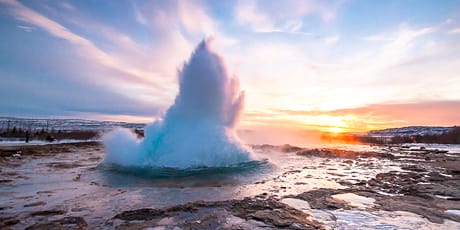 The Golden Circle route is Iceland's most popular sightseeing trail, providing an easy and efficient way to see three of the country's top attractions in a day. Each stop offers insight into Iceland's geologic history and excellent photo opportunities with bursting geysers, roaring waterfalls, and a fissure between two tectonic plates. The iconic route includes Þingvellir National Park, a UNESCO World Heritage Site; Geysir Geothermal Area, home to two famous geysers; and Gullfoss waterfall, Iceland's most spectacular waterfall.
The Golden Circle route is Iceland's most popular sightseeing trail, providing an easy and efficient way to see three of the country's top attractions in a day. Each stop offers insight into Iceland's geologic history and excellent photo opportunities with bursting geysers, roaring waterfalls, and a fissure between two tectonic plates. The iconic route includes Þingvellir National Park, a UNESCO World Heritage Site; Geysir Geothermal Area, home to two famous geysers; and Gullfoss waterfall, Iceland's most spectacular waterfall.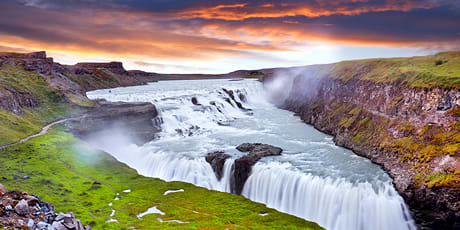 Located in the canyon along the Hvítá River, the mighty Gullfoss Waterfall attracts spectators year-round. "Gullfoss" translates to "Golden Falls," from the spectacular golden hue often shining in its glacial waters. Rushing waters plunge from 105 feet, and during its heaviest flow in the summer, it pours nearly 34,000 gallons of water every second! The great falls are known not only for their breathtaking power but also for the rainbows that appear above the falls on sunny days. Make sure your cameras are charged and ready to capture the stunning surrounding scenery, including the dramatic valley, rolling fields, and the magnificent ice sheet of Langjokull Glacier.
Located in the canyon along the Hvítá River, the mighty Gullfoss Waterfall attracts spectators year-round. "Gullfoss" translates to "Golden Falls," from the spectacular golden hue often shining in its glacial waters. Rushing waters plunge from 105 feet, and during its heaviest flow in the summer, it pours nearly 34,000 gallons of water every second! The great falls are known not only for their breathtaking power but also for the rainbows that appear above the falls on sunny days. Make sure your cameras are charged and ready to capture the stunning surrounding scenery, including the dramatic valley, rolling fields, and the magnificent ice sheet of Langjokull Glacier.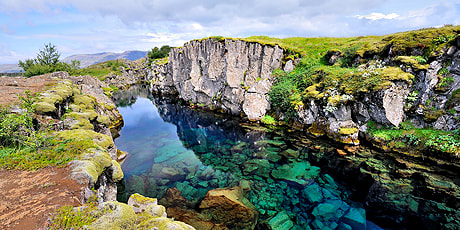 Iceland has established three national parks with unique nature and history. Explore Þingvellir National Park, a UNESCO World Heritage Site where the ancient Vikings had a parliament, making it one of the oldest parliaments in the world. The Þingvellir plain sits on a tectonic plate boundary where North America and Europe are slowly separating, resulting in the plain being scarred by dramatic fissures, ponds, and rivers, including the great rift Almannagjá. Journey to Europe's 2nd largest national park, Vatnajökull National Park, which covers about 14% of Iceland, and admire Jökulsárlón, a glacial lagoon filled with floating icebergs, Iceland's highest mountains, and Europe's largest glacier and the most powerful waterfall, Dettifoss. Finally, wander Snæfellsnes National Park and witness its mysterious Snæfellsjökull glacier, and then follow the adventure of Jules Verne's classic science-fiction novel, "The Journey to the Center of the Earth." This once-in-a-lifetime lava cave tour takes you over 114 ft underground and about 656 ft into the lava tube called Vatnshellir.
Iceland has established three national parks with unique nature and history. Explore Þingvellir National Park, a UNESCO World Heritage Site where the ancient Vikings had a parliament, making it one of the oldest parliaments in the world. The Þingvellir plain sits on a tectonic plate boundary where North America and Europe are slowly separating, resulting in the plain being scarred by dramatic fissures, ponds, and rivers, including the great rift Almannagjá. Journey to Europe's 2nd largest national park, Vatnajökull National Park, which covers about 14% of Iceland, and admire Jökulsárlón, a glacial lagoon filled with floating icebergs, Iceland's highest mountains, and Europe's largest glacier and the most powerful waterfall, Dettifoss. Finally, wander Snæfellsnes National Park and witness its mysterious Snæfellsjökull glacier, and then follow the adventure of Jules Verne's classic science-fiction novel, "The Journey to the Center of the Earth." This once-in-a-lifetime lava cave tour takes you over 114 ft underground and about 656 ft into the lava tube called Vatnshellir.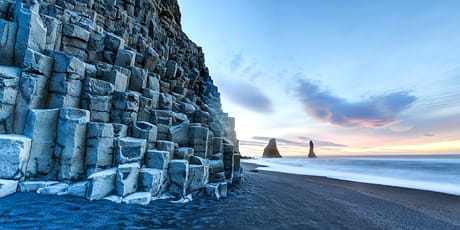 The Snæfellsnes Peninsula is a region in western Iceland known for its beautiful and dramatic landscapes with lava fields, volcanoes, glaciers, black and white beaches, and soaring coastal cliffs. The scenic peninsula is often nicknamed "Miniature Iceland" due to the wealth and diversity of natural features found there. At its western tip, a rugged mountain chain runs its length, capped by the 4700 ft Snæfellsjökull glacier, a mystical cone-shaped stratovolcano rising from the sea at the peninsula's tip, wrapped in mythical stories from the past and present.
The Snæfellsnes Peninsula is a region in western Iceland known for its beautiful and dramatic landscapes with lava fields, volcanoes, glaciers, black and white beaches, and soaring coastal cliffs. The scenic peninsula is often nicknamed "Miniature Iceland" due to the wealth and diversity of natural features found there. At its western tip, a rugged mountain chain runs its length, capped by the 4700 ft Snæfellsjökull glacier, a mystical cone-shaped stratovolcano rising from the sea at the peninsula's tip, wrapped in mythical stories from the past and present.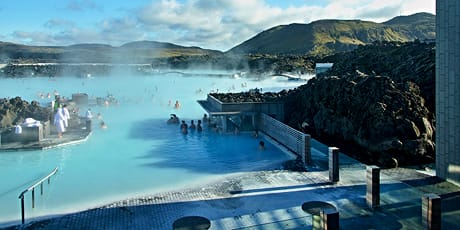 Located on the Reykjanes Peninsula in southwest Iceland, the famous Blue Lagoon is one of Iceland's most popular attractions, and it's little wonder why! The lagoon's blue, soothing waters full of rich skin nourishment benefits are unlike anything else on Earth. Contrary to belief, the lagoon is not a natural hot spring but a pool created by a human-made structure. The history dates back to 1976, when it was formed next to a geothermal power plant, Svartsengi. In the early 1980s, people began bathing in the calming water to alleviate skin conditions. Today, with 102ºF waters year-round, the Blue Lagoon is a world-class spa catering to hundreds of thousands of visitors annually.
Located on the Reykjanes Peninsula in southwest Iceland, the famous Blue Lagoon is one of Iceland's most popular attractions, and it's little wonder why! The lagoon's blue, soothing waters full of rich skin nourishment benefits are unlike anything else on Earth. Contrary to belief, the lagoon is not a natural hot spring but a pool created by a human-made structure. The history dates back to 1976, when it was formed next to a geothermal power plant, Svartsengi. In the early 1980s, people began bathing in the calming water to alleviate skin conditions. Today, with 102ºF waters year-round, the Blue Lagoon is a world-class spa catering to hundreds of thousands of visitors annually.